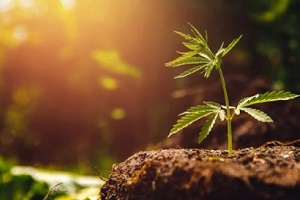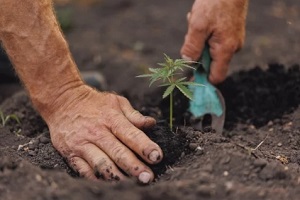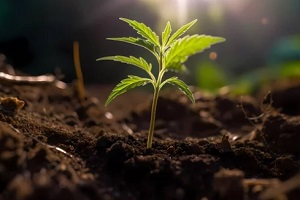 Water is just as valuable to plants as it is to humans—downright indispensable. For cannabis cultivation, ensuring optimal moisture levels isn’t just a task; it’s an art. Over-watering or under-watering can severely affect the growth and yield of your plants, but how do you strike the right balance for your cannabis soil?
Water is just as valuable to plants as it is to humans—downright indispensable. For cannabis cultivation, ensuring optimal moisture levels isn’t just a task; it’s an art. Over-watering or under-watering can severely affect the growth and yield of your plants, but how do you strike the right balance for your cannabis soil?
In this guide, we’ll explore the many methods and tools available to help you accurately measure and monitor your soil’s moisture, ensuring your cannabis plants thrive in just the right environment.
The Role and Relevance of Soil Moisture in Cannabis Cultivation
Maintaining the correct soil moisture level is vital when cultivating cannabis. Whether the soil tilts toward being overly damp or excessively parched, it can give rise to multiple horticultural challenges.
Over-watering
Oxygen is a lifeline for cannabis roots. If the soil becomes over-watered or waterlogged, it threatens the roots by depriving them of this essential element, potentially leading to ailments such as root rot and consequently, a weakened cannabis plant.
Under-watering
Soil that’s too dry poses its own set of challenges—it can hinder the plant’s growth, reduce the roots’ ability to absorb nutrients and add undue stress to the plant, resulting in poor yields when harvest time comes.
Identifying the Key Indicators of Inadequate Moisture Levels
Before diving deep into the tools that aid in moisture measurement, understanding the indicators of sub-optimal moisture conditions is vital to big buds and bigger harvests for your cannabis crop:
- Yellowing Leaves: This is an intriguing symptom as it can be an alert for both over-watering and under-watering. Observing the soil’s condition and other concurrent plant symptoms can clarify the exact cause.
- Limp or Drooping Leaves: This is a red flag for over-watering. When roots are deprived of oxygen, they struggle to support the plant, resulting in droopy leaves.
- Brittle or Brown Leaves: These are telltale signs of under-watering or severe dehydration.
Measuring Soil Moisture Accurately
The market today offers an array of tools to measure soil moisture. A brief overview of the most sought-after tools includes:
 Finger Test: A tried and tested method, it’s all about delving in and feeling the soil. Using your bare finger, a depth to about the second knuckle, check the soil—if the soil feels dry, it calls for watering. If it is damp, patience is the key; waiting a day or two before reassessing is advisable.
Finger Test: A tried and tested method, it’s all about delving in and feeling the soil. Using your bare finger, a depth to about the second knuckle, check the soil—if the soil feels dry, it calls for watering. If it is damp, patience is the key; waiting a day or two before reassessing is advisable.- Soil Moisture Meters: These are technologically advanced tools tailored for precision. They encompass a probe for soil insertion and a meter that quantitatively displays the moisture level.
- Weighing the Pot: A more intuitive method, lifting the pot provides a sense of its water content. A weightier pot indicates a moist soil substrate and a lighter one often signals the need for watering.
- Observation: This is for the seasoned growers. Over time, one can discern the soil’s moisture content by noting its hue and texture. Darker shades hint at higher moisture, while lighter tones suggest the opposite.
Tailoring Watering Techniques to Growth Stages
Cannabis plants, much like other botanical specimens, undergo distinct developmental phases, and each phase necessitates specific watering protocols:
Seedlings
In their earliest stage of life, cannabis seedlings are incredibly fragile. At this point, the soil should feel like a wrung-out sponge—damp, but not sopping wet. Over-watering can inundate their tender roots, risking suffocation and diseases.
Conversely, allowing the soil to dry out can hinder their delicate growth. The balance is downright vital here; it’s about ensuring the soil remains uniformly moist to support the fledgling roots, not waterlogged.
Vegetative Stage
As the cannabis plant matures and transitions into the vegetative stage, its robustness and water requirements surge. Thus, while the plant consumes more water overall, it’s also more forgiving of minor watering mishaps.
Typically, it’s a good practice to allow the top inch of the soil to dry out between waterings. This method encourages deeper root growth and ensures that the plant gets the oxygen it needs.
Flowering Stage
Arguably the most important phase for cultivators, the flowering stage sees the cannabis plant focusing its energy on producing buds. Water requirements remain elevated during this period, but caution is important because the risk of diseases, especially those like root rot, becomes accentuated.
Over-watering can be particularly detrimental, leading to moldy buds or compromised roots. As a rule of thumb, allowing the top 1-2 inches of soil to dry out between watering sessions is advisable. Consistency in watering, ensuring even moisture distribution, is also vital during this stage to support optimal bud development.
Strategies for Achieving the Moisture Goldilocks Zone
Several strategies can ensure the soil retains optimal moisture. Mulching, or using organic materials to cover the soil, can be a boon as it retains moisture and stabilizes the soil temperature.
A well-draining pot prevents the perils of over-watering, and when you do water, doing so evenly ensures that the moisture reaches all parts of the root system. Watering during cooler parts of the day, such as early mornings or late evenings, can also prove beneficial as it reduces water loss through evaporation.
Factors Shaping Cannabis Soil Moisture Dynamics
A myriad of external elements come into play when discussing soil moisture:
 Temperature and Humidity: High temperatures coupled with low humidity can cause the soil to lose moisture at an accelerated rate. Conversely, a cooler and humid environment tends to conserve soil moisture.
Temperature and Humidity: High temperatures coupled with low humidity can cause the soil to lose moisture at an accelerated rate. Conversely, a cooler and humid environment tends to conserve soil moisture.- Type of Soil: Soil type is pivotal. Sandy soils have a propensity to drain faster, while clayey counterparts tend to be more retentive.
- Pot Size and Material: The pot’s dimensions and material are influential. Smaller pots tend to dry out faster. Moreover, breathable materials like terracotta can lead to swifter evaporation than plastic ones.
Maintain Optimal Soil Moisture for Your Cannabis Plants
Each phase of growth, every sign of stress, and the tools used to measure and manage the aspects of soil moisture for cannabis plants play a pivotal role in ensuring a healthy and bountiful yield. While understanding these elements is essential for growing success, the foundation of successful cultivation starts with the quality of the soil itself.
Dirt Connections stands out well ahead of the competition as your ideal partner to help meet all of your soil-related needs. Renowned as a leading provider of dirt and soils, their commitment to quality ensures your plants get the superior start they deserve.
Ready to take your cultivation to the next level? Contact Dirt Connections at 1-703-940-9949 if you’re in Virginia or 1-301-691-3215 for Maryland, or further explore what they offer by visiting them online. Make the smart choice for your cannabis cultivation journey, and let Dirt Connections guide you every step of the way.
Summary

Dirt Connections was started with one goal in mind: providing quality residential and commercial construction services to clients on time and on budget. Reach out for more information on how we can support your next project.
For your convenience our estimates are free and by appointment. Call 703-940-9949 for a free estimate today!









































